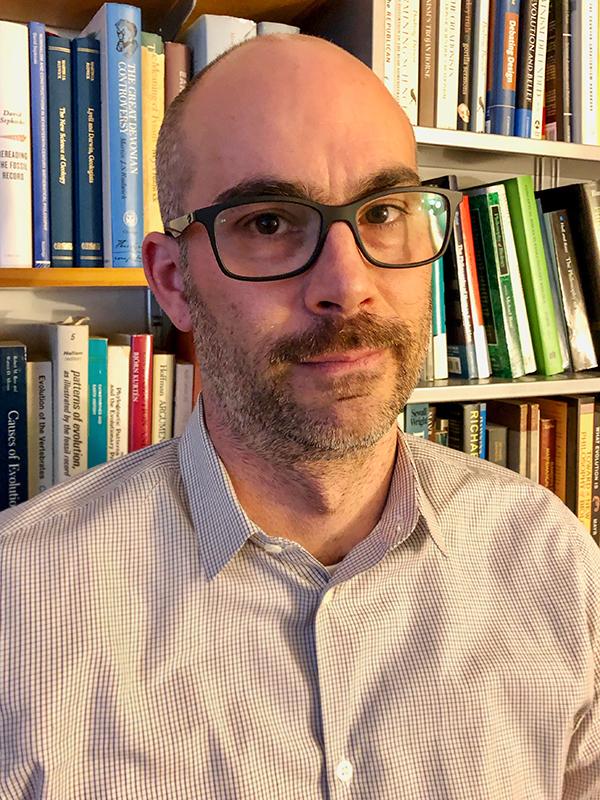
Photo: University of Illinois Urbana-Champaign history professor David Sepkoski studies the history of science. His new book “Catastrophic Thinking ” examines how the interplay of science and culture over two centuries has…
view more
Credit Image: Photo by Teri Chettiar
CHAMPAIGN, Ill. — A global pandemic, wildfires and hurricanes have made 2020 a year for catastrophic thinking, so a new book with that title seems appropriate.
But don’t mistake David Sepkoski’s “Catastrophic Thinking” as a doomsday warning about the future. It’s focused instead on how we got here – how our current-day concerns regarding threats to both the planet and the human race came to be.
Sepkoski travels through two centuries of history, “from Darwin to the Anthropocene,” to examine how science and culture have interacted to shape those views, especially on extinction and the value of diversity. One example came in the 1980s, when a new scientific theory that the dinosaurs’ extinction resulted from a massive meteor strike coincided with rising public anxiety over nuclear annihilation.
Sepkoski is the Thomas M. Siebel Chair in History of Science at the University of Illinois Urbana-Champaign, and focuses much of his research on how science influences, and is influenced by, the larger society. Contrary to some perceptions that science stands apart, he said, “Scientific developments are interwoven into the culture, politics and ideologies of the time.”
That’s illustrated early in Sepkoski’s book in describing the contention over two theories of extinction during the 1800s. One, championed by Charles Darwin, an Englishman, said species died out slowly and continuously over time. The other, promoted by Georges Cuvier, a Frenchman, theorized that species came to an end primarily through large catastrophic events. Each drew on scientific evidence, but each also was influenced by politics and their support or distrust of political revolution.
Likewise, the science and culture of the 1800s had little notion of the inherent value of biological or cultural diversity, Sepkoski said. People worried about the loss of a given “charismatic” species, but not about its effect on the stability of ecosystems or the larger environment. The end of a species or culture was more likely to be viewed as part of a natural process.
“The notion that diversity has inherent value is treated self-evidently by many scientists today, as is cultural diversity by many others,” Sepkoski said. “But the emergence of that idea has been very complex, involving interactions over time between people in diverse realms of human inquiry, from genetics and ecology to the humanities, anthropology and other disciplines.
“In other words, it didn’t just materialize out of thin air. Nor was it an inevitable way, or even a natural way, of thinking for many people.”
Sepkoski traces the evolution of these ideas through the 20th century in the context of trends in society at large – from the onset of a modernist pessimism in Europe early in the century and through the world wars, to Cold War anxieties around nuclear proliferation and what has come since.
He makes it personal by noting the influence of his paleontologist father, who was involved in the new theory on dinosaur extinction, and describes the impact on him as a child watching the TV film “The Day After,” depicting the aftermath of a nuclear war.
“What happens in the second half of the 20th century is that the pervasive sense of doom that early 20th-century Europeans felt gets amped up to a much more immediate sense that a catastrophe could visit us literally at any moment,” Sepkoski said.
“Those sorts of things conditioned a broader public to accept a model of crisis we’re now absorbed in – this rhetoric of biodiversity loss, or of a sixth mass extinction. We cannot understand that particular model of extinction and threat looking only at the science. We have to understand also the huge contribution of changing cultural attitudes and values and concerns.”
Sepkoski also noted that the catastrophic thinking of today is different from the Cold War fears about nuclear war. “Rather than being terrified of a bomb that’s going to wipe us out in an eyeblink, we have learned to live in a state of constant slow-motion crisis or catastrophe. That’s the way we’ve come to view the environmental crisis that we’re facing. That’s the way we’re viewing the pandemic. It is simultaneously a state of hope and despair.
“The silver lining to this slow-motion view of apocalypse is that there’s some hope we might still have a chance to remediate it in some way. We might have some possibility of addressing it.”
###
TDnews (tunisiesoir.com)














